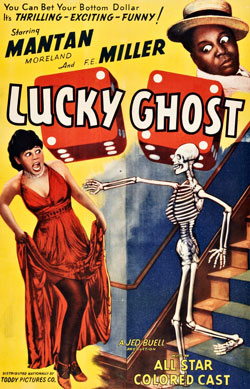Jim Crow Museum
1010 Campus Drive
Big Rapids, MI 49307
[email protected]
(231) 591-5873
If you ever watch old scary movies with Pigmeat Markham, Mantan Moreland and Willie Best it is clear that these movies portrayed blacks in stereotypical ways, especially as buffoons scared of ghosts. Too bad blacks didn't make their own scary movies.
-- Simon Lackton - Eugene, Oregon

Without much fanfare, African Americans have starred in all-black horror movies since the early portion of the 20th century. For the most part, the films have been low-budget, independently financed affairs that have reached few people beyond their target demographic. However, by the end of the century, major studios had dipped their toes into the sub-genre with all-black fare like Bones and Tales From the Hood. The African-American horror marketplace has gone through several distinct cycles since the advent of the motion picture industry and continues to evolve today.
The earliest all-black films, called "race movies," were segregated more out of necessity than by choice, due to the limited opportunities available to African-American actors in the Hollywood studio system. While most race movies were polite melodramas and murder mysteries featuring educated, upper-class protagonists, a string of more bawdy, working-class comedies also proved to be popular.
It's these comedies that were the most likely of the race films to feature horror elements -- primarily haunted houses or voodoo curses. Comedians Mantan Moreland (Lucky Ghost, Mr. Washington Goes to Town, Professor Creeps) and Pigmeat Markham (Mr. Smith Goes Ghost, Fight That Ghost) in particular headlined several such movies.

The use of black comedians in horror comedies even extended to major studio productions, with Moreland featured in King of the Zombies, Revenge of the Zombies and several Charlie Chan mysteries. Additionally, Willie Best costarred in The Ghost Breakers with Bob Hope, Eddie "Rochester" Anderson played a significant role in Topper Returns and Nick Stewart spiced up Zombies on Broadway with his wit. As prominent as these comedic roles were, though, they tended to reinforce African-American stereotypes (including an overly superstitious fear of ghosts).
That said, several of the more somber, dramatic race films also featured horrific themes. Typically, they revolved around voodoo and religion, like Drums o' Voodoo, The Devil's Daughter with Nina Mae McKinney and Ouanga with Fredi Washington; or occasionally, they played out like a typical monster movie of the era, like Son of Ingagi.
African-American roles in horror movies all but dried up in the next two decades, however, for a couple of reasons. First, the 1950s witnessed the start of an era of integration on the big screen, as all-black race films faded into obscurity. Second, movie studios began to display a heightened sense of responsibility to show African-Americans in a positive light due to pressure from civil rights groups. Thus, black roles in "low-brow" fare like horror movies dried up, as did work for comedic actors like Mantan Moreland.
In 1971, the so-called "blaxploitation" era began as a backlash against integrated films that had either marginalized black characters or presented them in such bland terms that they were rendered unrepresentative. While most of the 200-plus blaxploitation movies released in the decade were crime dramas and action adventures, quite a few of them fell into the horror genre.
Much of blaxploitation horror simply put an African-American spin on establish works like Dracula (Blacula), Frankenstein (Blackenstein), Dr. Jekyll and Mr. Hyde (Dr. Black, Mr. Hyde) and even The Exorcist (Abby), but often these films rose beyond their basic premises with strong acting and direction. Original plots like the zombie revenge flick Sugar Hill, the cerebral vampire tale Ganja and Hess and ghost stories The House on Skull Mountain and J.D.'s Revenge further added depth to the era's black horror offerings.
All good things, though, must come to an end. By the start of the 1980s, studios had glutted the market with all-black fare, thus ensuring smaller and smaller profits. To some, the uniqueness of the blaxploitation genre had become stale. Hollywood assumed that the "fad" had run its course and abruptly cut funding for such films. Thus, most all-black movies produced in the decade -- horror or otherwise -- had to be made outside of the studio system.
The only black horror movies of note filmed during that time came from writer/director Chester Norvell Turner. His Black Devil Doll From Hell and Tales From the Quadead Zone were so cheap and poorly made and, in the case of Devil Doll in particular, contained such scandalous content that they have since become cult favorites.
By the early 1990s, young black filmmakers like Spike Lee, Robert Townsend, John Singleton and Keenan Ivory Wayans had begun to fill the void left by the sudden end of the blaxploitation era. Their ability to create quality material with popular appeal showed studios that films with primarily African-American casts could indeed be marketable. In particular, movies with realistic, sympathetic portrayals of "urban" themes of crime, violence, drugs and poverty became in vogue.
Within this atmosphere of acceptance grew several all-black horror movies with urban settings, which soon became known as "urban horror." These included Bones, Tales From the Hood, Def By Temptation and a pair from established horror master Wes Craven: The People Under the Stairs and Vampire in Brooklyn.
Later in the '90s, as technological advances made filmmaking more accessible to everyday people, urban horror exploded on home video. Companies like Full Moon and Maverick produced a slew of cheaply made urban horror releases benefiting from the popularity of hip-hop culture, including Killjoy, Ragdoll, Hood Rat, Cryptz, Zombiez, The Evil One and Urban Menace. Since then, direct-to-video movies under the urban horror moniker -- which has come to embody all African-American horror, regardless of locale -- have become a steady force within the horror genre, with even the already-established Leprechaun franchise shifting its focus towards "the hood."
December 2009 response courtesy of
Mark Harris
About.com Guide to Horror/Suspense